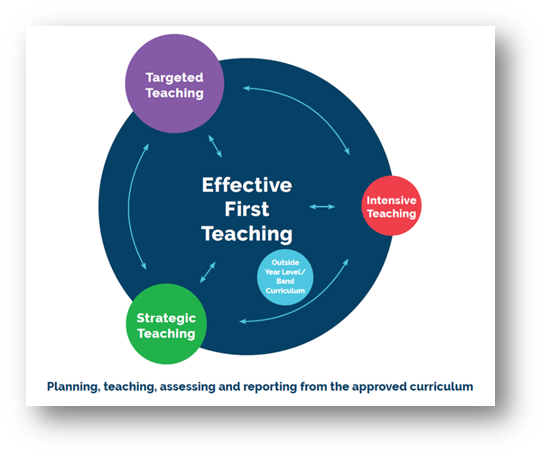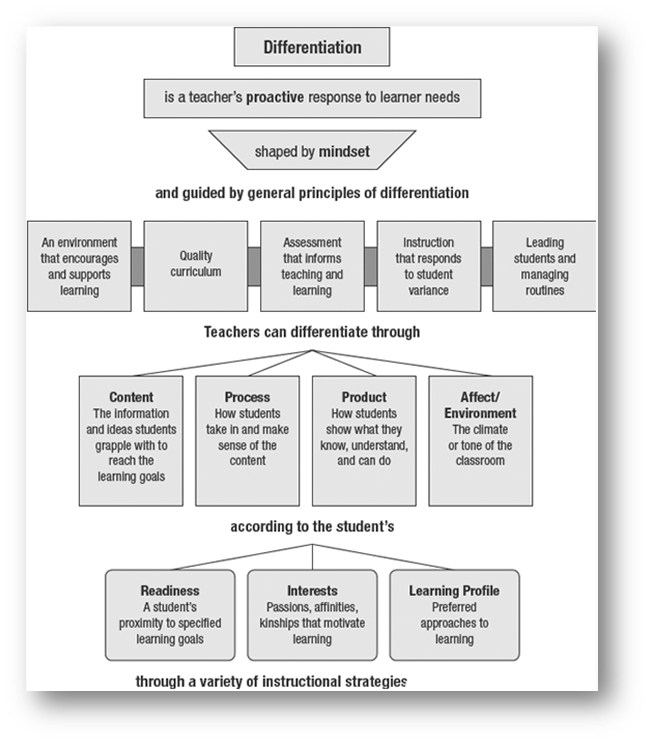All students engage within effective first teaching, while also receiving the targeted, strategic, or intensive support that they may need at different times or in different learning areas.
Adjustments relevant to Nationally Consistent Collection of Data (NCCD) may apply at any stage. The processes of NCCD exist concurrently within the Levels of Teaching Response.

Figure 3: Levels of Teaching Response
Source: Levels of Teaching Responses (BCE, May 2023)
Differentiation, Adjustments, and Interventions
'A good, differentiated teaching program means high quality, evidence-based instruction that meets students' needs within their zone of proximal learning development and has clear SMART (Specific, Measurable, Achievable, Realistic and Time-based) goals.' (www.education.vic.gov.au, 2019)
Definition.
Differentiation involves valuing and proactively responding to the learning needs of every student, so that each student receives the right amount of support and challenge that enables them to progress in their learning.
Differentiation is an entitlement for all students and a key component of Effective first teaching. (See above)
There is a strong preference in BCE for differentiation to interconnect with personalised learning to ensure that there are opportunities for students to be leaders of their own learning. (BCE, 2021)
“Across the grades, when instruction was challenging, relevant, and academically demanding, then all students had higher engagement and teachers talked less – and the greatest beneficiaries were at-risk students."
― John A.C. Hattie, Visible Learning for Teachers: Maximizing Impact on Learning, 2018
Adjustments and interventions are additional supports provided for some students who are experiencing difficulties with learning, accessing the curriculum, or achieving their potential.
Differentiation is a key high-impact teaching strategy (HITS) used by teachers to craft lessons that provide the right amount of support and challenge for every student.
Differentiated teaching can ensure that all students can master their individual objectives and continually grow even if they aren't necessarily at the same starting level.
Ways to differentiate:
1. Content
· Deliver different parts of the curriculum to different students depending on their starting level and what you expect them to learn in that lesson.
2. Product
· When you adjust the product of a lesson, you are changing how students demonstrate they have met the specific success criteria.
3. Process
· This means changing the methods you use to teach and how you expect students to learn. Gradual Release of Responsibility Model.
4. Affect / Environment
· This means taking into consideration the climate and tone of the classroom such as:
· how students' emotions and feelings impact their learning (affect)
· the physical and emotional context in which learning occurs (environment)
Student Considerations when Differentiating
· Readiness - a student's current proximity to specific knowledge, understanding, and skills
· Interests - which engages the attention, curiosity, and involvement of the student
· Learner Profile – preferred approaches to learning
This is achieved through well-considered, planned responses that address all learners' needs, every day, across all curriculum learning areas. Figure 1.1 shows a summary of the elements required for an effective differentiated instruction.
Key Elements Effective Differentiated Instruction
The key elements of effective differentiated instruction are summed up by Tomlinson (2017).

Figure 4: Key Elements of Effective Differentiated Instruction
Source: (Tomlinson, 2017) Key Elements of Effective Differentiated Instruction